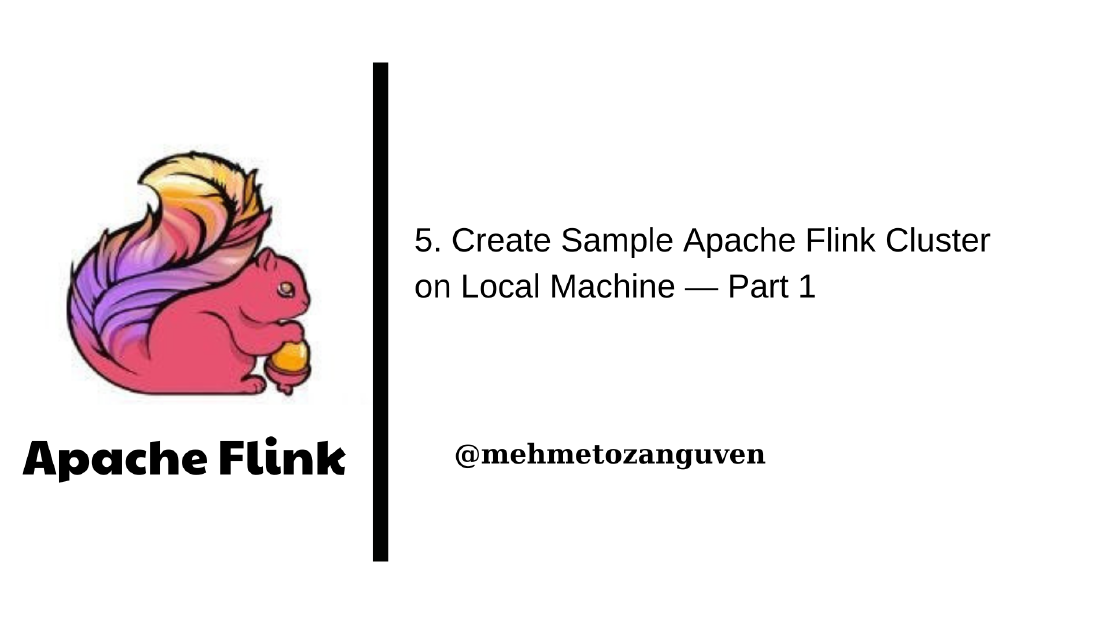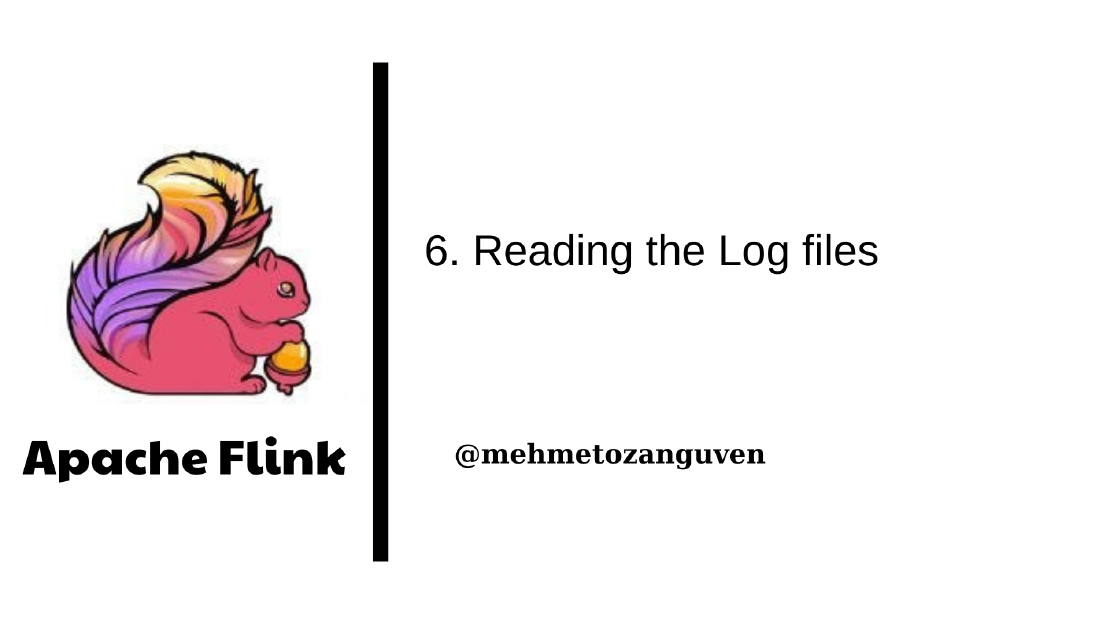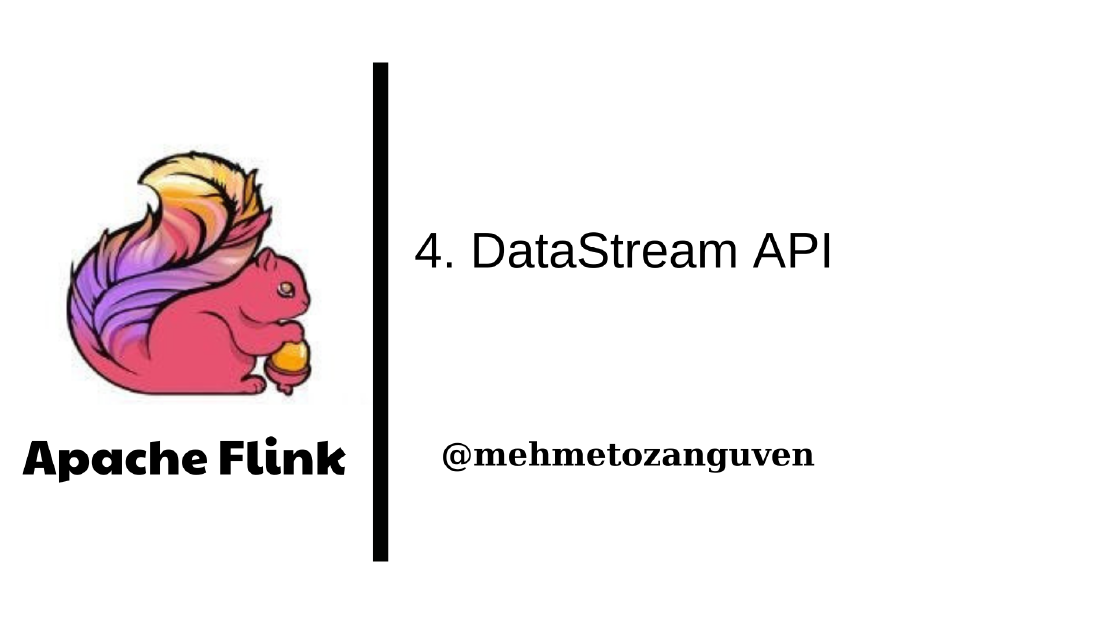
Apache Flink Series 5 — Create Sample Apache Flink Cluster on Local Machine — Part 1
In this post, we are creating simple Flink cluster own local machine. Before diving into creating cluster, configuration and etc.. let’s summarize …

In this post, we will look at the log files (both for TaskManager and JobManager) and try to understand what is going on Flink cluster.
Actually this post will be about the step 3 for creating sample Flink cluster. However, I just thought that reading logs files would be a great improvement to understand basic of any tools/framework etc.. Therefore I decided to write about post for that.
From the previous blog, we could run simple flink cluster with one JobManager along with a TaskManager.
Let’s re-process this, with only one task slot (setting the numberOfTaskSlots to 1 in the flink-conf.yaml file):
taskmanager.numberOfTaskSlots: 1
Now run your cluster with: $ pathToFlink/bin/start-cluster.sh
Note: If you run flink cluster before, you can delete logs from the previous setup. Otherwise flink will append the newly created log to the existing ones
2020-02-28 00:03:44,009 INFO org.apache.flink.runtime.entrypoint.ClusterEntrypoint - Starting StandaloneSessionClusterEntrypoint (Version: 1.10.0, Rev:aa4eb8f, Date:07.02.2020 @ 19:18:19 CET)
Because we are creating Standalone cluster, Flink will also create the appropriate classes for Standalone. If you look at the Flink source, you will see that ClusterEntrypoint is a abstract class and there is a class called StandaloneSessionClusterEntrypoint which extends it.
(1)
2020-02-28 00:03:44,009 INFO org.apache.flink.runtime.entrypoint.ClusterEntrypoint - OS current user: mehmetozanguven
(2)
2020-02-28 00:03:44,010 INFO org.apache.flink.runtime.entrypoint.ClusterEntrypoint - Current Hadoop/Kerberos user: <no hadoop dependency found>
(3)
2020-02-28 00:03:44,010 INFO org.apache.flink.runtime.entrypoint.ClusterEntrypoint - JVM: OpenJDK 64-Bit Server VM - AdoptOpenJDK - 11/11.0.6+10
(4)
2020-02-28 00:03:44,010 INFO org.apache.flink.runtime.entrypoint.ClusterEntrypoint - Maximum heap size: 1024 MiBytes
(5)
2020-02-28 00:03:44,010 INFO org.apache.flink.runtime.entrypoint.ClusterEntrypoint - JAVA_HOME: /home/mehmetozanguven/JavaJDKS/jdk-11.0.6+10
Logs that gives information(the environment, like code revision, current user, Java version and JVM parameters), like the above will be print in the method:
org.apache.flink.runtime.util.EnvironmentInformation.logEnvironmentInfo(...)
For example java_home component is reading like this
logEnvironmentInfo(...) {
// ...
String javaHome = System.getenv("JAVA_HOME");
//...
}
And all the information about system, environment etc… will be print in here:
logEnvironmentInfo(...){
log.info("--------------------------------------------------------------------------------");
log.info(" Starting " + componentName + " (Version: " + version + ", "
+ "Rev:" + rev.commitId + ", " + "Date:" + rev.commitDate + ")");
log.info(" OS current user: " + System.getProperty("user.name"));
log.info(" Current Hadoop/Kerberos user: " + getHadoopUser());
log.info(" JVM: " + jvmVersion);
log.info(" Maximum heap size: " + maxHeapMegabytes + " MiBytes");
log.info(" JAVA_HOME: " + (javaHome == null ? "(not set)" : javaHome));
}
After that we see these logs in the JobManager’s log file:
2020-02-28 00:03:44,010 INFO org.apache.flink.runtime.entrypoint.ClusterEntrypoint - JVM Options:
2020-02-28 00:03:44,010 INFO org.apache.flink.runtime.entrypoint.ClusterEntrypoint - -Xms1024m
2020-02-28 00:03:44,010 INFO org.apache.flink.runtime.entrypoint.ClusterEntrypoint - -Xmx1024m
2020-02-28 00:03:44,011 INFO org.apache.flink.runtime.entrypoint.ClusterEntrypoint - -Dlog.file=/home/mehmetozanguven/Desktop/ApacheTools/flink-1.10.0/log/flink-mehmetozanguven-standalonesession-0-mehmetozanguven-ABRA-A5-V5.log
2020-02-28 00:03:44,011 INFO org.apache.flink.runtime.entrypoint.ClusterEntrypoint - -Dlog4j.configuration=file:/home/mehmetozanguven/Desktop/ApacheTools/flink-1.10.0/conf/log4j.properties
2020-02-28 00:03:44,011 INFO org.apache.flink.runtime.entrypoint.ClusterEntrypoint - -Dlogback.configurationFile=file:/home/mehmetozanguven/Desktop/ApacheTools/flink-1.10.0/conf/logback.xml
Nothing but Flink reads JVM options that passed on the startup, you may think that “we just started the cluster via .sh file who passed the -Dlog.file/log4j etc.. ?”
These system properties is passed by another .sh file called config.sh
This file looks at the flink-conf.yaml, if it finds the key value parameter for any of these system properties, it will use it, otherwise default value will be used.
2020-02-28 00:03:44,011 INFO org.apache.flink.runtime.entrypoint.ClusterEntrypoint - Program Arguments:
2020-02-28 00:03:44,011 INFO org.apache.flink.runtime.entrypoint.ClusterEntrypoint - --configDir
2020-02-28 00:03:44,011 INFO org.apache.flink.runtime.entrypoint.ClusterEntrypoint - /home/mehmetozanguven/Desktop/ApacheTools/flink-1.10.0/conf
2020-02-28 00:03:44,011 INFO org.apache.flink.runtime.entrypoint.ClusterEntrypoint - --executionMode
2020-02-28 00:03:44,011 INFO org.apache.flink.runtime.entrypoint.ClusterEntrypoint - cluster
2020-02-28 00:03:44,011 INFO org.apache.flink.runtime.entrypoint.ClusterEntrypoint - Classpath: /home/mehmetozanguven/Desktop/ApacheTools/flink-1.10.0/lib/flink-table_2.11-1.10.0.jar:/home/mehmetozanguven/Desktop/ApacheTools/flink-1.10.0/lib/flink-table-blink_2.11-1.10.0.jar:/home/mehmetozanguven/Desktop/ApacheTools/flink-1.10.0/lib/log4j-1.2.17.jar:/home/mehmetozanguven/Desktop/ApacheTools/flink-1.10.0/lib/slf4j-log4j12-1.7.15.jar:/home/mehmetozanguven/Desktop/ApacheTools/flink-1.10.0/lib/flink-dist_2.11-1.10.0.jar:::
Flink reads the program arguments (command line arguments) and prints it if found. Then Flink will also print the classpath to execute java classes. These information is also printted in the EnvironmentInformation.logEnvironmentInfo(…) method
if (commandLineArgs == null || commandLineArgs.length == 0) {
log.info(" Program Arguments: (none)");
}
else {
log.info(" Program Arguments:");
for (String s: commandLineArgs) {
log.info(" " + s);
}
}
log.info(" Classpath: " + System.getProperty("java.class.path"));
log.info("--------------------------------------------------------------------------------");
As also mentioned before these parameter was set by config.sh file
2020-02-28 00:03:44,029 INFO org.apache.flink.configuration.GlobalConfiguration - Loading configuration property: jobmanager.rpc.address, localhost
2020-02-28 00:03:44,029 INFO org.apache.flink.configuration.GlobalConfiguration - Loading configuration property: jobmanager.rpc.port, 6123
2020-02-28 00:03:44,029 INFO org.apache.flink.configuration.GlobalConfiguration - Loading configuration property: jobmanager.heap.size, 1024m
2020-02-28 00:03:44,029 INFO org.apache.flink.configuration.GlobalConfiguration - Loading configuration property: taskmanager.memory.process.size, 1568m
2020-02-28 00:03:44,029 INFO org.apache.flink.configuration.GlobalConfiguration - Loading configuration property: taskmanager.numberOfTaskSlots, 1
2020-02-28 00:03:44,029 INFO org.apache.flink.configuration.GlobalConfiguration - Loading configuration property: parallelism.default, 1
2020-02-28 00:03:44,030 INFO org.apache.flink.configuration.GlobalConfiguration - Loading configuration property: jobmanager.execution.failover-strategy, region
Flink reads the keys from conf/flink-conf.yaml and print the values.
Here is the one important log line that placed almost at the bottom:
2020-02-28 00:03:46,412 INFO org.apache.flink.runtime.resourcemanager.StandaloneResourceManager - Registering TaskManager with ResourceID c1438b06b128b7faf16b60e06f404f05 (akka.tcp://[email protected]:36981/user/taskmanager_0) at ResourceManager
This line basically says that “TaskManager whose id c1438b06b128b7faf16b60e06f404f05 registers itself to the ResourceManager.”
After that JobManager requests a task slot from ResourceManager to execute client’s tasks(streams actually).
2020-02-28 00:03:44,843 INFO org.apache.flink.runtime.taskexecutor.TaskManagerRunner - Starting TaskManager (Version: 1.10.0, Rev:aa4eb8f, Date:07.02.2020 @ 19:18:19 CET)
TaskManagerRunner is the entry point for the TaskManager in standalone mode. This class constructs the related components such as memory manager, network, I/O manager etc…
2020-02-28 00:03:45,846 INFO org.apache.flink.runtime.taskexecutor.TaskManagerRunner - Starting TaskManager with ResourceID: c1438b06b128b7faf16b60e06f404f05
TaskManager id (called ResourceId) is generated in the method:
public final class
org.apache.flink.runtime.clusterframework.types.ResourceId ... {/**
* Generate a random resource id.
*
* @return A random resource id.
*/
public static ResourceID generate() {
return new ResourceID(new AbstractID().toString());
}
}
Let’s look at the logs statement where TaskManager registers itself to the resource manager:
2020-02-28 00:03:46,176 INFO org.apache.flink.runtime.taskexecutor.TaskExecutor - Connecting to ResourceManager akka.tcp://flink@localhost:6123/user/resourcemanager(00000000000000000000000000000000).
2020-02-28 00:03:46,336 INFO org.apache.flink.runtime.taskexecutor.TaskExecutor - Resolved ResourceManager address, beginning registration
2020-02-28 00:03:46,336 INFO org.apache.flink.runtime.taskexecutor.TaskExecutor - Registration at ResourceManager attempt 1 (timeout=100ms)
2020-02-28 00:03:46,426 INFO org.apache.flink.runtime.taskexecutor.TaskExecutor - Successful registration at resource manager akka.tcp://flink@localhost:6123/user/resourcemanager under registration id b266a3eeb6c19ada5969142c1ffb2651.
Logs clearly indicates that “what is going on”, I suppose.
That’s for this post. Hopefully I will go with part 2 for Creating Sample Apache Flink Cluster.
Last but not least, wait for the next post …

In this post, we are creating simple Flink cluster own local machine. Before diving into creating cluster, configuration and etc.. let’s summarize …

In this post, I am going to explain DataStream API in Flink. You may see the all my notes about Apache Flink with this link When we look at the Flink …